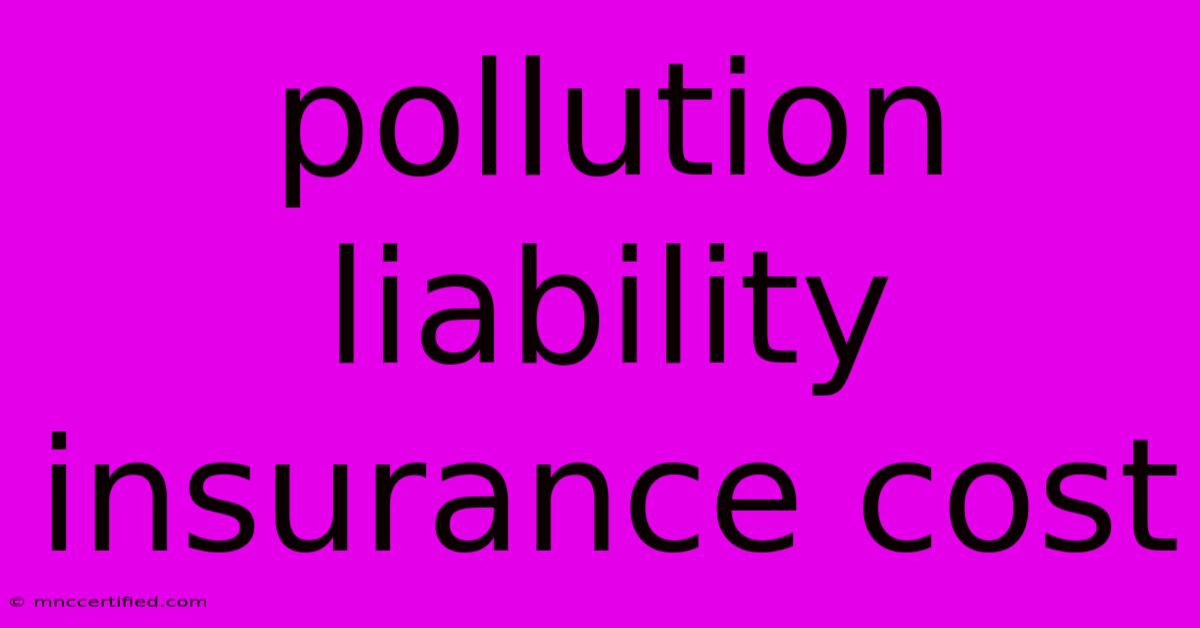Pollution Liability Insurance Cost

Table of Contents
Pollution Liability Insurance Cost: A Comprehensive Guide
Pollution liability insurance is a crucial coverage for businesses handling potentially hazardous materials. Understanding the cost of this insurance is vital for budgeting and risk management. This comprehensive guide will delve into the factors influencing pollution liability insurance premiums, helping you navigate the complexities and make informed decisions.
What Factors Determine Pollution Liability Insurance Cost?
Several interconnected factors significantly impact the cost of pollution liability insurance. These aren't independent variables; rather, they interact to create a unique premium for each policyholder.
1. Type of Business and Operations:
Your industry plays a dominant role. High-risk industries, such as manufacturing, chemical processing, and waste management, face considerably higher premiums than low-risk industries. The specific operations within your business also matter. For example, a manufacturing plant using hazardous chemicals will pay more than a similar plant using less hazardous materials.
2. Location:
The geographic location of your business influences the cost. Areas with stringent environmental regulations and a higher likelihood of pollution incidents generally command higher premiums. State and local regulations, along with the proximity to sensitive environments like waterways or protected lands, are key considerations.
3. Coverage Limits:
The higher your policy limits, the more expensive your insurance will be. This reflects the increased potential financial liability the insurer assumes. Carefully assess your potential exposure to pollution-related claims when determining the appropriate coverage limits.
4. Pollution History:
A clean environmental record translates to lower premiums. Any past pollution incidents, even minor ones, can significantly increase your insurance cost. Insurers meticulously examine your past and present environmental compliance records. Maintaining a robust environmental management system (EMS) is crucial for mitigating risk and reducing premiums.
5. Claims History:
Similar to pollution history, a history of insurance claims, regardless of their nature, can impact your premiums. Insurers assess the overall risk profile of your business, and prior claims, even those unrelated to pollution, can signal higher risk.
6. Insurance Provider:
Different insurance companies have varying risk assessments and pricing models. Comparing quotes from multiple providers is essential to securing the most competitive rate. Look beyond price; consider the insurer’s financial stability and reputation for claims handling.
7. Deductible:
Choosing a higher deductible will typically lower your premium. However, it's essential to balance cost savings with your financial capacity to absorb a larger initial claim expense.
Minimizing Pollution Liability Insurance Costs
While some factors are beyond your control, proactive measures can significantly reduce your premiums.
- Implement robust environmental management practices: This includes regular environmental audits, employee training, and spill prevention plans.
- Maintain meticulous records: Accurate and readily available records demonstrating your commitment to environmental compliance are essential.
- Invest in pollution prevention technologies: Implementing technologies that minimize waste and emissions can significantly reduce risk.
- Secure multiple quotes: Comparing quotes from multiple insurers ensures you obtain the most competitive rate.
- Work with a knowledgeable insurance broker: An experienced broker understands the intricacies of pollution liability insurance and can guide you through the process, helping you secure optimal coverage at a reasonable price.
Conclusion: A Proactive Approach to Cost Management
Pollution liability insurance is not a luxury but a necessity for many businesses. By understanding the factors that influence cost and taking proactive steps to manage risk, businesses can secure appropriate coverage without incurring excessive premiums. Remember, a thorough understanding of your operations, environmental compliance, and risk profile is crucial for securing the most cost-effective pollution liability insurance. Don't hesitate to consult with environmental professionals and insurance brokers to tailor your coverage and minimize your costs.

Thank you for visiting our website wich cover about Pollution Liability Insurance Cost. We hope the information provided has been useful to you. Feel free to contact us if you have any questions or need further assistance. See you next time and dont miss to bookmark.
Featured Posts
-
Nations League Stakes 2026 Wc Qualification
Nov 16, 2024
-
Portugals 1974 Revolution Figure Dies
Nov 16, 2024
-
Cheryl Honors Ex Liam Payne
Nov 16, 2024
-
Scottish Greens Free Football Matches
Nov 16, 2024
-
Jake Paul Vs Mike Tyson Date Time Odds Viewing
Nov 16, 2024